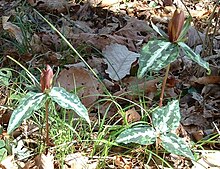| Trillium decipiens | |
|---|---|

| |
| Jackson County, Florida | |
| Conservation status | |
 Vulnerable (NatureServe) | |
| Scientific classification | |
| Kingdom: | Plantae |
| Clade: | Tracheophytes |
| Clade: | Angiosperms |
| Clade: | Monocots |
| Order: | Liliales |
| Family: | Melanthiaceae |
| Genus: | Trillium |
| Species: | T. decipiens |
| Binomial name | |
| Trillium decipiens J.D.Freeman | |
Trillium decipiens, also known as Chattahoochee River wakerobin or deceiving trillium, is a spring-flowering perennial plant. It occurs mostly near the Chattahoochee River in Alabama, Florida and Georgia. Scattered populations are found elsewhere in these three states, all within the Atlantic Coastal Plain or Gulf Coastal Plain. Rich deciduous woods of bluffs, ravines, and alluvial land provide its most favored habitat.
Description

Trillium decipiens is a sessile-flowered trillium, that is, it has no flower stalk. The flower has three purple, brown, or green (rarely yellow) petals that stand upright at the junction of the three strikingly mottled leaves. It is one of the earliest trilliums, often starting to bloom in January or February.
Trillium decipiens is often confused with Trillium underwoodii but the two species are easily distinguished by plant height. In the case of T. underwoodii, the stem is 1–1.5 times longer than the leaves at flowering, whereas with T. decipiens, the stem is 2.5–3 times longer than the leaves.
Taxonomy
Trillium decipiens was first described by John Daniel Freeman in 1975. Phylogenetic analysis has since shown a lack of separation between T. decipiens and T. underwoodii, indicating the need to re-evaluate their status as distinct species.
Bibliography
- Case, Frederick W.; Case, Roberta B. (1997). Trilliums. Portland, Oregon: Timber Press. ISBN 978-0-88192-374-2.
- Freeman, J. D. (1975). "Revision of Trillium subgenus Phyllantherum (Liliaceae)". Brittonia. 27 (1): 1–62. doi:10.2307/2805646. JSTOR 2805646. S2CID 20824379.
References
- "Trillium decipiens". NatureServe Explorer. NatureServe. Retrieved 16 November 2021.
- NRCS. "Trillium decipiens". PLANTS Database. United States Department of Agriculture (USDA). Retrieved 15 December 2015.
- Case Jr., Frederick W. (2002). "Trillium decipiens". In Flora of North America Editorial Committee (ed.). Flora of North America North of Mexico (FNA). Vol. 26. New York and Oxford: Oxford University Press – via eFloras.org, Missouri Botanical Garden, St. Louis, MO & Harvard University Herbaria, Cambridge, MA.
- "Trillium decipiens". County-level distribution map from the North American Plant Atlas (NAPA). Biota of North America Program (BONAP). 2014. Retrieved 7 October 2019.
- Trillium decipiens Retrieved March 18, 2015.
- Case & Case (1997), pp. 176–179.
- Freeman (1975), pp. 17–20.
- Schilling, Edward E.; Floden, Aaron; Lampley, Jayne; Patrick, Thomas S.; Farmer, Susan B. (2019). "A New Species of Trillium (Melanthiaceae) from Central Georgia and its Phylogenetic Position in subgenus Sessilium". Systematic Botany. 44 (1): 107–114. doi:10.1600/036364419X697958. S2CID 91263667.
External links
- Citizen science observations for Trillium decipiens at iNaturalist
- Biodiversity Information Serving Our Nation (BISON) occurrence data and maps for Trillium decipiens
| Taxon identifiers | |
|---|---|
| Trillium decipiens |
|